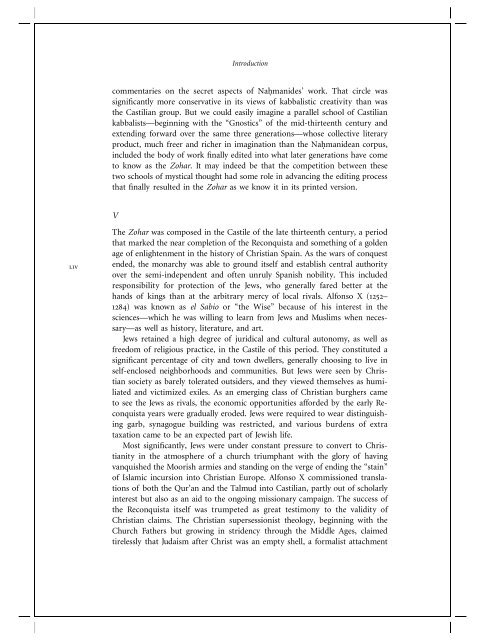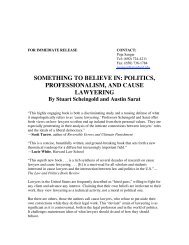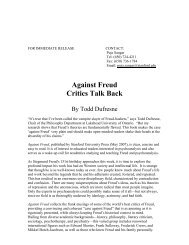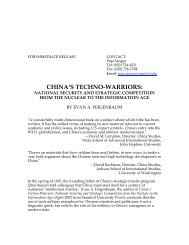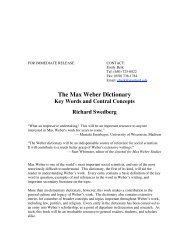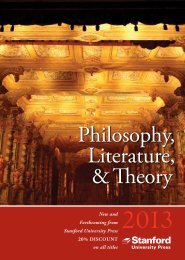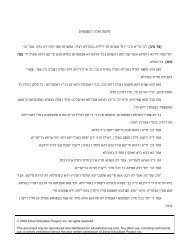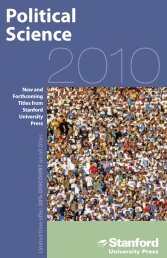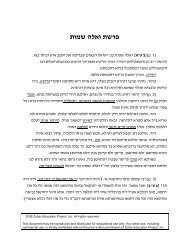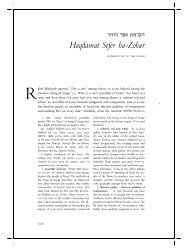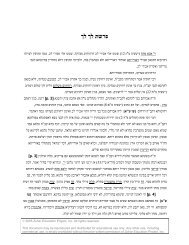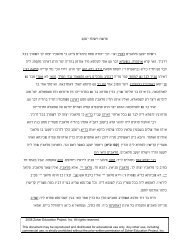Front Matter (PDF) - Stanford University Press
Front Matter (PDF) - Stanford University Press
Front Matter (PDF) - Stanford University Press
Create successful ePaper yourself
Turn your PDF publications into a flip-book with our unique Google optimized e-Paper software.
on the secret aspects of Naḥmanides' work. That circle was<br />
commentaries<br />
more conservative in its views of kabbalistic creativity than was<br />
signi®cantly<br />
Castilian group. But we could easily imagine a parallel school of Castilian<br />
the<br />
with the ``Gnostics'' of the mid-thirteenth century and<br />
kabbalistsÐbeginning<br />
over the same three generationsÐwhose collective literary<br />
extendingforward<br />
much freer and richer in imagination than the Naḥmanidean corpus,<br />
product,<br />
the body of work ®nally edited into what later generations have come<br />
included<br />
know as the Zohar. It may indeed be that the competition between these<br />
to<br />
schools of mystical thought had some role in advancingthe editingprocess<br />
two<br />
®nally resulted in the Zohar as we know it in its printed version.<br />
that<br />
Zohar was composed in the Castile of the late thirteenth century, a period<br />
The<br />
marked the near completion of the Reconquista and somethingof a golden<br />
that<br />
of enlightenment in the history of Christian Spain. As the wars of conquest<br />
age<br />
the monarchy was able to ground itself and establish central authority<br />
ended,<br />
the semi-independent and often unruly Spanish nobility. This included<br />
over<br />
for protection of the Jews, who generally fared better at the<br />
responsibility<br />
of kings than at the arbitrary mercy of local rivals. Alfonso X (1252±<br />
hands<br />
was known as el Sabio or ``the Wise'' because of his interest in the<br />
1284)<br />
he was willingto learn from Jews and Muslims when necessaryÐas<br />
sciencesÐwhich<br />
well as history, literature, and art.<br />
retained a high degree of juridical and cultural autonomy, as well as<br />
Jews<br />
of religious practice, in the Castile of this period. They constituted a<br />
freedom<br />
percentage of city and town dwellers, generally choosing to live in<br />
signi®cant<br />
neighborhoods and communities. But Jews were seen by Chris-<br />
self-enclosed<br />
society as barely tolerated outsiders, and they viewed themselves as humiliatetian<br />
and victimized exiles. As an emerging class of Christian burghers came<br />
see the Jews as rivals, the economic opportunities afforded by the early Reconquista<br />
to<br />
years were gradually eroded. Jews were required to wear distinguish-<br />
synagogue buildingwas restricted, and various burdens of extra<br />
inggarb,<br />
came to be an expected part of Jewish life.<br />
taxation<br />
signi®cantly, Jews were under constant pressure to convert to Christianity<br />
Most<br />
in the atmosphere of a church triumphant with the glory of having<br />
the Moorish armies and standingon the verge of endingthe ``stain''<br />
vanquished<br />
Islamic incursion into Christian Europe. Alfonso X commissioned transla-<br />
of<br />
of both the Qur'an and the Talmud into Castilian, partly out of scholarly<br />
tions<br />
but also as an aid to the ongoing missionary campaign. The success of<br />
interest<br />
Reconquista itself was trumpeted as great testimony to the validity of<br />
the<br />
claims. The Christian supersessionist theology, beginning with the<br />
Christian<br />
Fathers but growing in stridency through the Middle Ages, claimed<br />
Church<br />
that Judaism after Christ was an empty shell, a formalist attachment<br />
tirelessly<br />
Introduction<br />
V<br />
liv


